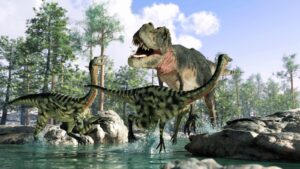Dinosaurs, the awe-inspiring creatures that once roamed the Earth, continue to captivate imaginations and fuel scientific curiosity. These ancient reptiles dominated the planet for over 160 million years, leaving behind a rich fossil record that offers glimpses into their diverse and fascinating world. However, just as the extinction of dinosaurs serves as a stark reminder of the fragility of life, impaired well-being highlights the vulnerabilities that individuals can face in their mental and physical health.
Drawing:Sdn2sx5y0y0= Dinosaur

Dinosaur animals, a diverse group of reptiles, lived during the Mesozoic Era, which spanned from 252 to 66 million years ago. These species thrived in various environments and evolved distinct features to adapt to their habitats. The Mesozoic Era, divided into three periods—Triassic, Jurassic, and Cretaceous—saw significant evolutionary changes among dinosaurs. Much like mastering multiple desktops on macOS, which allows users to organize tasks and streamline workflows, dinosaurs adapted their diverse characteristics to navigate and dominate their environments effectively. Just as users can create different spaces for various activities on their computers, dinosaurs evolved unique traits that enabled them to thrive in the varied landscapes of the Mesozoic world.
Triassic Period (252-201 million years ago): Early dinosaurs, such as Herrerasaurus and Eoraptor, appeared during this period. These dinosaurs were generally smaller and shared traits with earlier archosaurs.
Jurassic Period (201-145 million years ago): This period marked the rise of larger dinosaurs like Brachiosaurus and Allosaurus. Herbivores and carnivores diversified, leading to advanced ecosystems.
Cretaceous Period (145-66 million years ago): The era saw the dominance of iconic species like Tyrannosaurus rex and Triceratops. Rapid evolution resulted in new niches, and flowering plants transformed the landscape.
Discovery And Fossils Of Dinosaur Animals
Notable Excavations
 Several key excavations have shaped the knowledge of dinosaurs. In 1824, William Buckland described Megalosaurus, marking the first scientific identification of a dinosaur. In 1858, Joseph Leidy’s description of Hadrosaurus sparked public interest due to its bipedal posture. The discovery of Archaeopteryx, in 1861 in Germany, provided a pivotal link between dinosaurs and birds, due to its feathered features.
Several key excavations have shaped the knowledge of dinosaurs. In 1824, William Buckland described Megalosaurus, marking the first scientific identification of a dinosaur. In 1858, Joseph Leidy’s description of Hadrosaurus sparked public interest due to its bipedal posture. The discovery of Archaeopteryx, in 1861 in Germany, provided a pivotal link between dinosaurs and birds, due to its feathered features.
The “Bone Wars,” a rivalry between paleontologists Edward Cope and Othniel Marsh in the late 19th century, led to the rapid discovery of numerous species in the western United States. These discoveries included well-known dinosaurs such as Stegosaurus and Triceratops, significantly enriching the fossil record.
Famous Fossil Locations
Certain locations are renowned for yielding remarkable dinosaur fossils. The Morrison Formation in the western United States holds one of the most diverse collections of late Jurassic dinosaur fossils, including large sauropods like Apatosaurus and Diplodocus. The Hell Creek Formation, spanning regions in Montana, South Dakota, and North Dakota, is famous for late Cretaceous fossils, notably Tyrannosaurus rex and Triceratops.
The Extinction Of Dinosaur Animals
Theories And Evidence
 Researchers identify the asteroid impact and volcanic activity as primary extinction causes. Walter and Luis Alvarez introduced the asteroid impact theory in 1980, supported by the high level of iridium in the K-Pg boundary layer. This element, rare on Earth but abundant in asteroids, indicates a large asteroid struck the Yucatán Peninsula, forming the Chicxulub crater. The impact triggered tsunamis, earthquakes, and wildfires.
Researchers identify the asteroid impact and volcanic activity as primary extinction causes. Walter and Luis Alvarez introduced the asteroid impact theory in 1980, supported by the high level of iridium in the K-Pg boundary layer. This element, rare on Earth but abundant in asteroids, indicates a large asteroid struck the Yucatán Peninsula, forming the Chicxulub crater. The impact triggered tsunamis, earthquakes, and wildfires.
Volcanic eruptions in present-day India, known as the Deccan Traps, also likely contributed. These eruptions released massive volumes of lava and gases, leading to climate changes. Sulfur dioxide from volcanic activity likely caused acid rain and a temperature drop, adversely affecting plant and animal life.
Impact On Modern Science
Dinosaur extinction theories significantly influence modern science. The recognition of asteroid impacts highlights the potential threat of future collisions, leading to monitoring programs like NASA’s Near-Earth Object Observations. Understanding these events enhances preparedness for similar potential threats.
The extinction event also underscores the delicate balance of ecosystems, guiding current climate change research. Scientists draw parallels between historical volcanic activity and contemporary global warming, enhancing climate models and predictions.
Extinction Insights
Dinosaurs continue to captivate the imagination and curiosity of people worldwide. Their legacy, etched in fossils and popular culture, offers a window into a world that once was. As paleontologists unearth new findings and technology advances, our understanding of these magnificent creatures deepens.
